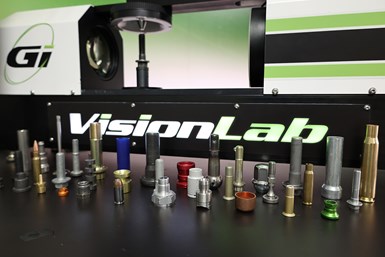The precision machining industry is getting together in-person for the first time in over two years at the Precision Machining Technology Show (PMTS) 2021 set for August 10-12, 2021, in Cleveland, Ohio, at the Huntington Convention Center.
As the economy’s momentum continues to accelerate, now is a great time to look for new ways to make your business more efficient and productive. PMTS brings a broad range of technologies together all in one place to make your research time more effective.
Production Machining wants to make it even easier for you with a series of PMTS Product Previews highlighting a variety of new products and technologies that will be displayed at the show. Here, we’re looking at automation and measurement technologies that will be on display at PMTS, including a robotic cell that enables quick and easy setups and portability for low- or high-production shops; an instant part measurement machine that gives dimensional data and pass/fail feedback; a sorter with tilted platen for part transport before, during and after inspection; and more.
Before you go to the show, don’t miss PMTS show highlights in Derek Korn’s latest column. Look for more PMTS Product Roundups and individual product highlights in our extensive online PMTS Preview Section and don’t forget to register for the show.
If you would like to learn more about the latest news, product technology and operational best practices in the precision machining industry, consider subscribing to Production Machining's free monthly print magazine.
Click on each link below to read the full PMTS product preview:
Safe, Industrial Robotic Machine-Tending Cell
Absolute Machine Tools, in cooperation with Mitsubishi Electric’s Automation division, offers the LoadMate Plus robotic machine tending cell which is engineered to be a compact, portable and durable robotic cell for shops requiring the strength of an industrial robot with safe, collaborative functionality. This cost-effective robotic cell allows for quick and easy setups and portability for low- or high-production shops. Additional guarding and fencing might not be necessary when LoadMate Plus is positioned properly in close proximity with a CNC machine tool.
Methods Machine Tools’ standard automation system, JobShop Cell Pro (JSC Pro), is designed to integrate with a FANUC RoboDrill for unmanned machining. The machine incorporates a main enclosure with several different pre-engineered end-of-arm and infeed/outfeed options for a range of part and capacity requirements. This Pro version accommodates multiple infeed and outfeed options for high-mix, medium-volume machining applications.
SPC Innovations’ modular Detector ETC System is designed for real-time, in-machine part inspection and broken tool detection. The system is built on the proven effectiveness of the existing Detector line of gages, while adding electronic broken tool monitoring capabilities in one simple display, the company says. The modular design enables gages and probes to be added or moved from machine to machine with minimal additional setup cost. The ETC System features real-time, in-machine inspection and corrective action.
The Oasis Inspection System is an instant part measurement machine that gives dimensional data and pass/fail feedback when the part is placed on the pedestal. Operators see red (out of tolerance), green (good) or yellow (warn) status display bars instantly, without even pressing a button.
Inspection System Analyzes Complete Part Layouts
General Inspection’s VisionLab is designed to be a versatile, noncontact gaging and inspection system capable of providing complete part layouts in less than five seconds, the company says. The system provides 360-degree dimensional inspection, 360-degree visual defect detection, end view inspection (dimensions and visual defects), plus complete data reporting with seamless integration into standard SPC programs. With 0.002 mm accuracy and submicron repeatability, the company says users can save time and money while making significant quality improvements.
Six Sigma Concepts has partnered with Resec Systems to produce the Orion197, a variant of Resec’s J197 tilted platen sorter. Both use a tilted platen for part transport before, during and after inspection. Cylindrical parts such as screws, pins and spools rest against a metal guide rail while the glass platen beneath them rotates. The motion of the rotating glass along with the constraint of the rail results in a uniform part velocity along the metal guide rail, the company says.
Schwäbische Werkzeugmaschinen’s (SW) BA 322i is designed to function as an independent manufacturing cell that can store enough workpieces for an entire shift. This twin-spindle horizontal machining center produces twice the output while using less floor space and less energy. The BA W02 and BA 3 series are available with a loading module with an integrated six-axis robot and vertical workpiece storage. SW’s double-swivel carrier enables loading and unloading in parallel to machining time.
RELATED CONTENT
-
Manufacturing cells are used to minimize product movement as well as materials, equipment and labor during the manufacturing process. By reducing cycle times and material handling, these cells help shops more easily meet customer demands regarding cost, quality and leadtimes.
-
The bar feeder is the most common form of automation for turning operations. Selecting the right one requires consideration of the applications for which it will be used.
-
Companies that are not currently using automation in their manufacturing processes should be considering it.













